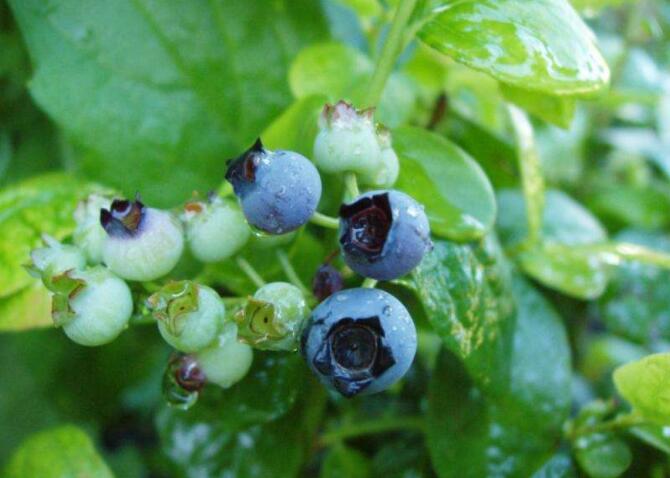(单词翻译:单击)
听力文本
Climate Change Affects Maine’s Blueberry Crops
Maine's wild blueberry fields are home to one of the most important fruit crops in the northeastern United States. But scientists working with the University of Maine have found they are warming at a faster rate than the rest of the state.
The researchers say the blueberries may be at risk because the rising temperatures have brought a loss of water.
The scientists studied 40 years of data and found that the state experienced a 1.1 degrees Celsius increase in average temperature. But the blueberry fields experienced an increase of 1.3 degrees Celsius.
The team's findings appeared in a study earlier this year in the research journal Water.
Rafa Tasnim is an ecology and environmental science student at the University of Maine and the study's lead writer. She said the lack of water caused by the temperature difference could result in smaller crop sizes and blueberries that are less likely to survive.

"What we are expecting is the temperature is going to increase a lot and we will not get as much rainfall in the summertime especially," said Tasnim.
Maine is home to the only for-profit producers of wild blueberries in the U.S. The berries are smaller and have a slightly different flavor than other kinds of blueberries. Most of the crop is used to supply frozen fruit. Maine growers compete with those in eastern Canada which also produce the fruit.
The wild blueberry industry in Maine has been affected in recent years by unpredictable markets, as well as last year's lack of water. Farmers produced 21.5 million kilograms of Maine wild blueberries last year. That was the lowest number since 2004.
The researchers found that wild blueberry growers might need to change the way they farm to prepare for future climate change. That could include changes to watering methods and fertilizer use.
Eric Venturini is executive director of the Wild Blueberry Commission of Maine. He says the industry is ready to make those changes.
Venturini added that the organization is working to find out how climate change is affecting the blueberry industry and looking for ways to deal with those changes.
The berries are widely used in processed food products. In recent years, Maine and its growers have worked to market the berries as a superfood – a food containing compounds considered helpful to a person's health.
The blueberries are also part of yearly agricultural events and the main ingredient of blueberry pie, the state's official dessert. And Maine's official berry is, not too surprisingly, the blueberry.
I'm Jonathan Evans.
重点解析
重点讲解:
1. as well as 和...一样;不但...而且
This year numerous bands are playing, as well as comedy acts.
今年有许多乐队在表演,也有喜剧节目。
2. find out 找出;查明
If there has been any funny business, we'll soon find out.
如果有任何非法的事,我们会很快发现的。
3. be ready to do 准备好做...
She's ready to learn simple addition and subtraction.
她准备学习简单的加法和减法。
4. compete with 与...比较
We can't compete with them on price.
我们在价格上无法与他们竞争。
参考译文
气候变化影响缅因州的蓝莓生长
缅因州的野生蓝莓田是美国东北部最重要的水果作物之一。但与缅因州大学合作的科学家们发现,东北部的变暖速度比该州的其他地区更快。
研究人员表示,因为气温上升导致水分流失,蓝莓可能面临风险。
科学家们研究了40年的数据,发现该州的平均气温上升了1.1摄氏度。而蓝莓田的温度却上升了1.3摄氏度。
今年早些时候,该团队的研究结果发表在《水》(Water)杂志上。
拉法·塔斯尼姆(Rafa Tasnim)是缅因州大学生态学和环境科学专业的学生,也是这项研究的主要作者。她说,温度差异导致的缺水可能会导致作物规模缩减,蓝莓也不太可能存活。
塔斯尼姆称:“我们预计气温将大幅上升,尤其是在夏季,我们将不会有那么多降雨。”
缅因州是美国野生蓝莓营利性生产商的所在地。这种蓝莓体积较小,味道与其他蓝莓略有差异。大部分蓝莓用于供应冷冻水果。缅因州的种植者与加拿大东部的蓝莓种植者一直在竞争。
近年来,缅因州的野生蓝莓产业受到了不可预测的市场和去年缺水的影响。去年缅因州农民生产了2150万公斤野生蓝莓。这是自2004年以来的最低数字。
研究人员发现,野生蓝莓种植者可能需要改变他们的种植方式,以应对未来的气候变化。这可能包括改变灌溉方法和化肥使用方式。
埃里克·文图里尼(Eric Venturini)是缅因州野生蓝莓委员会的执行董事。他说,该行业已经准备好做出这些改变。
文图里尼补充说,该组织正在试图了解气候变化如何影响蓝莓产业,并寻找应对这些变化的方法。
蓝莓被广泛用于加工类食品。近年来,缅因州及其种植者一直在努力将这种浆果作为一种超级食物进行营销——这种水果含有对人体健康有益的化合物。
蓝莓也是每年农业活动的一部分,也是该州官方甜点蓝莓派的主要原料。缅因州的官方浆果是蓝莓,这一点也不奇怪。
乔纳森·埃文斯为您播报。
译文为可可英语翻译,未经授权请勿转载!


